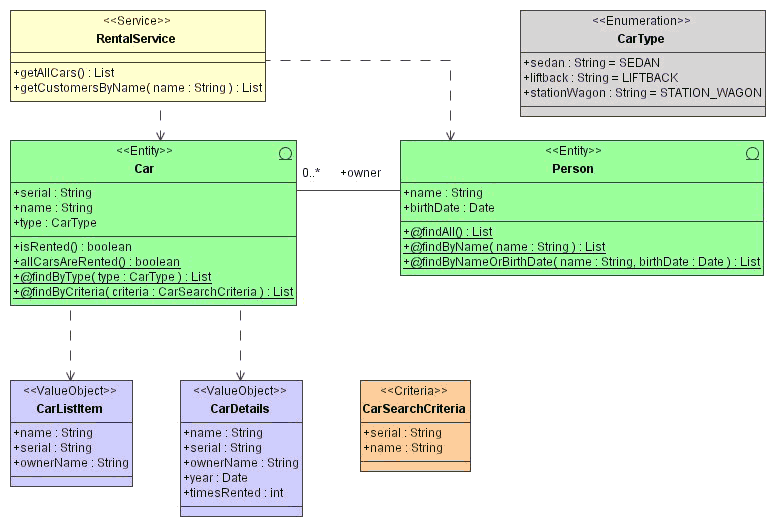Parent Project
Overview
How-to
- Introduction
- Entities
- Relationships
- Services
- Value Objects
- Enumerations
- Queries
- Exceptions
- Security
- Tips & Tricks
Project Documentation

All enterprise applications need to perform operations on the underlying datasource, and Hibernate supports this quite well with it's Hibernate Query Language.
UML also allows you to specify queries, be it in a more generic language. For this purpose OCL can be used, which supports body constructs since OCL 2.0. Although you can choose to override any generated query using a tagged value specifying your custom query it is strongly recommended to use OCL since this will guarantee your code to remain portable over different technologies. If you don't want to get to know OCL and have no problem sticking to Hibernate then you might consider using tagged values instead.
Finder methods require the query flag to be set, usually operations with this flag have the commercial at symbol '@' in front of their name when displayed in diagrams. Make sure you model the operation in classifier scope, in diagrams this will show them as underlined. Actually, classifier scoped operations go into the DAO while instance scoped operations go into the entity's implementation class (they are considered to be business operations).
For simple finders the cartridge will be able to generate the proper HQL without even requiring you to write any OCL constraint! Just make sure to enable that query flag and name the operation findByXXX(XXX : type) where XXX stands for the property on which you would like to search, for example: findByUserName(userName : String). The finder must return a collection type or the type of the underlying entity. In the former case the query is simply executed and the results are returned, in the latter case the first element from the result set is returned after being cast to the proper type. This is all done automatically and you won't need to worry about anything, there's no need to write any HQL yourself or to implement any method. Check the entity's DAO to learn what else you can do with the newly generated code (such as automatic conversion of the result set into value objects).
The documentation discussing the modeling of queries in UML is found here: Query Translation-Library Modeling. The tagged value overriding queries using Hibernate QL directly is found here: andromda_hibernate_query.

Notice how one of the classes has been labeled <<Criteria>> and used in one of the queries. This will yield a specific piece of code allowing a search on any combination of existing properties.
Tagged values may be added to the attributes of such a class. They are interesting when you want to wire the attributes to specific properties of the domain model. You can also set the comparator for the criteria search (equal, like, less, ...) or define certain attributes to be included in the search even if they are null. You can even activate result set ordering (ascending / descending) by just applying two tagged values to one or more criteria search attributes. For more details go here: Tagged Values.
These criteria objects allow to set the maximum number of elements to fetch, just do something like this:
// we need to find cars with name 'audi' only CarSearchCriteria searchCriteria = new CarSearchCriteria(null, "audi"); // after 1200 cars are found we stop searching searchCriteria.setMaximumResultSize(new Integer(1200)); // initiate the search by calling the DAO List audis = getCarDao().findByCriteria(searchCriteria);
It's allowed to override queries such as finders in the DAO, just override the appropriate method in an entity's DAO implementation class. What follows is an example of a code snippet overriding a generated HQL query (example taken from a ficticous UserDAOImpl class):
public List findActiveUsers(int transform)
{
// the next query is user-specified and overrides the one generated in super.findActiveUsers(int transform)
return super.findActiveUsers(transform, "from org.andromda.test.Users as user where user.exitDate is null");
}
You might consider doing this when you think the generated query is not performant enough, or when you need to do something which is so complex the OCL translation can't properly handle it.
The next section will cover the modeling of exceptions, click here to go to that section.